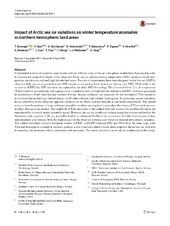| dc.contributor.author | Köenigk, Torben | |
| dc.contributor.author | Gao, Yongqi | |
| dc.contributor.author | Gastineau, Guillaume | |
| dc.contributor.author | Keenlyside, Noel | |
| dc.contributor.author | Nakamura, Tetsu | |
| dc.contributor.author | Ogawa, Fumiaki | |
| dc.contributor.author | Orsolini, Yvan | |
| dc.contributor.author | Semenov, Vladimir A. | |
| dc.contributor.author | Suo, Lingling | |
| dc.contributor.author | Tian, Tian | |
| dc.contributor.author | Wang, Tao | |
| dc.contributor.author | Wettstein, Justin | |
| dc.contributor.author | Yang, Shuting | |
| dc.date.accessioned | 2019-02-18T16:05:13Z | |
| dc.date.available | 2019-02-18T16:05:13Z | |
| dc.date.issued | 2018-07-30 | |
| dc.Published | Köenigk, Gao Y, Gastineau G, Keenlyside N, Nakamura T, Ogawa F, Orsolini Y, Semenov VA, Suo L, Tian T, Wang T, Wettstein J, Yang S. Impact of Arctic sea ice variations on winter temperature anomalies in northern hemispheric land areas. Climate Dynamics. 2018:1-27 | eng |
| dc.identifier.issn | 0930-7575 | en_US |
| dc.identifier.issn | 1432-0894 | en_US |
| dc.identifier.uri | https://hdl.handle.net/1956/19105 | |
| dc.description.abstract | Coordinated numerical ensemble experiments with six different state-of-the-art atmosphere models have been used in order to evaluate the respective impact of the observed Arctic sea ice and sea surface temperature (SST) variations on air temperature variations in mid and high latitude land areas. Two sets of experiments have been designed; in the first set (EXP1), observed daily sea ice concentration and SST variations are used as lower boundary forcing over 1982–2014 while in the second set (EXP2) the SST variations are replaced by the daily SST climatology. The observed winter 2 m air temperature (T2m) variations are relatively well reproduced in a number of mid and high latitude land areas in EXP1, with best agreement in southwestern North America and northern Europe. Sea ice variations are important for the interannual T2m variations in northern Europe but have limited impact on all other mid and high latitude land regions. In particular, sea ice variations do not contribute to the observed opposite variations in the Arctic and mid latitude in our model experiments. The spread across ensemble members is large and many ensemble members are required to reproduce the observed T2m variations over northern Europe in our models. The amplitude of T2m anomalies in the coldest observed winters over northern Europe is not reproduced by our multi-model ensemble means. However, the sea ice conditions in these respective winters and mainly the thermodynamic response to the ice anomalies lead to an enhanced likelihood for occurrence of colder than normal winters and extremely cold winters. Still, the main reason for the observed extreme cold winters is internal atmospheric dynamics. The coldest simulated northern European winters in EXP1 and EXP2 between 1982 and 2014 show the same large scale T2m and atmospheric circulation anomaly patterns as the observed coldest winters, indicating that the models are well able to reproduce the processes, which cause these cold anomalies. The results are robust across all six models used in this study. | en_US |
| dc.language.iso | eng | eng |
| dc.publisher | Springer | en_US |
| dc.rights | Attribution CC BY | eng |
| dc.rights.uri | http://creativecommons.org/licenses/by/4.0/ | eng |
| dc.title | Impact of Arctic sea ice variations on winter temperature anomalies in northern hemispheric land areas | en_US |
| dc.type | Peer reviewed | |
| dc.type | Journal article | |
| dc.date.updated | 2018-10-30T09:58:07Z | |
| dc.description.version | publishedVersion | en_US |
| dc.rights.holder | Copyright 2018 The Authors | en_US |
| dc.identifier.doi | https://doi.org/10.1007/s00382-018-4305-1 | |
| dc.identifier.cristin | 1605737 | |
| dc.source.journal | Climate Dynamics | |
| dc.relation.project | Norges forskningsråd: 244166 | |

